Lockheed EC-121 Warning Star Video - Overview
|
|
Lockheed EC-121 Warning Star
EC-121 Warning Star
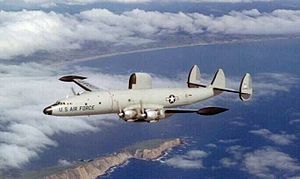
Picture - EC-121T Warning Star
Role: Airborne early warning aircraft
Manufacturer: Lockheed
First flight: 9 June 1949
Introduced: 1954
Retired: 1982 (USN)
Primary users: United States Navy
United States Air Force
Produced: 1953-1958
Number built: 232
Developed from: Lockheed Constellation
The Lockheed EC-121 Warning Star was a United States Navy/United States Air Force airborne early warning radar surveillance aircraft. A military version of the Lockheed Constellation, it was designed to serve as an airborne early warning system to supplement the Distant Early Warning Line, using two large radomes, a vertical dome above and a horizontal one below the fuselage. EC-121's were also used for intelligence gathering (SIGINT).
It was introduced in 1954 and retired from service in 1978, although a single specially-modified EW aircraft remained in service with the U.S. Navy until 1982. The US Navy versions when initially procured were designated WV-1 (PO-1W), WV-2, and WV-3. Warning Stars of the U.S. Air Force served during the Vietnam War as both electronic sensor monitors and as a forerunner to the E-3 Sentry AWACS. U.S. Air Force aircrews adopted the civil nickname, "Connie" (diminutive of Constellation) as reference, while naval aircrews used the term "Willie Victor".
Development
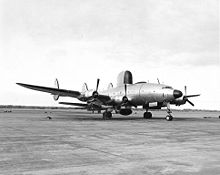
Picture - The second PO-1W prototype at NAS Barbers Point in 1952.
Since 1943 the Lockheed Constellation had been in USAAF service as the C-69. The use of the Constellation by the US Navy for patrol and airborne early warning duties was first investigated in 1949, when the Navy acquired two Lockheed L-749s. First flown on 9 June 1949, the PO-1W carried large, long-range radars in massive radomes above and below the fuselage. As the radomes produced considerable more side area, the fins of the PO-1W had to be increased. After the PO-1W, which was redesignated WV-1 in 1952, had proved that it was possible to operate large radars on aircraft, the US Navy ordered the WV-2 based on the L-1049 Super Constellation. The WV-1s were later transferred to the Federal Aviation Agency in 1958-59.
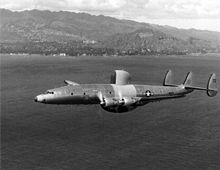
Picture - The third production WV-2 in flight in 1954.
The WV-2/EC-121D was initially fitted with a dorsal AN/APS-45 height finder radar and a ventral AN/APS-20 air search radar. These radars were later upgraded to AN/APS-103 and AN/APS-95 radars, although not simultaneously. The crew commonly numbered 18, six officers (two pilots, two navigators, two weapons controllers) and twelve enlisted personnel (two flight engineers, one radio operator, two crew chiefs, five radar operators, two radar technicians). However, when North Korea shot down a Navy EC-121 in 1969, a crew of 31 was on board.
Orders were placed totalling 142 PO-2W Constellations with deliveries beginning in 1953. The type was redesignated WV-2 in 1954. The WV-2 was familiarly known to its crews as "Willy Victor". In 1962, with standardization of aircraft designations within the Department of Defense, the WV-2 then became the EC-121K. 13 of these were converted to WV-2Q electronic intelligence aircraft (which became EC-121M in 1962), and 9 were converted to WV-3 weather reconnaissance aircraft (WC-121N in 1962). A single aircraft became an NC-121K, an electronic warfare variant assigned to VAQ-33 and the last EC-121 in operational service, flying until 25 June 1982.
The Air Force received 10 RC-121C and 74 EC-121D Warning Stars beginning with diversions from the Navy contracts in October 1953. The 10 RC-121Cs became trainers, designated TC-121C. Between 1966 and 1969, 30 retired Navy EC-121s were transferred to the USAF and converted in EC-121Rs as sensor-monitoring aircraft. Of the 74 EC-121s, 42 were converted to the EC-121H upgrade beginning in 1962, and in 1969, 15 of the remaining EC-121Ds and 7 of the EC-121Hs were further upgraded into the final operational variant, the EC-121T, which served as an AWACS prototype in Southeast Asia in 1972. Five EC-121Ds were modified to be broadcasting aircraft for psychological warfare operations, the predecessors of the EC-130 Commando Solo.
Operational service
WV-2s served from 1956 to 1965 in two "barrier" forces, one off each coast of the North American continent. These barrier forces consisted of five surface picket stations each manned by radar destroyer escorts and an air wing of WV-2s that patrolled the picket lines at 1,000-4,000 m (3,000-12,000 ft) altitude in 6 to 20-hour missions. Their objective was to extend early warning coverage against surprise Soviet bomber and missile attack as an extension of the DEW Line.
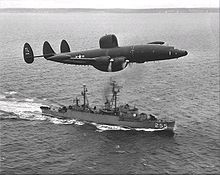
Picture - An Atlantic barrier WV-2 of VW-15 off Newfoundland in 1957.
The Atlantic Barrier (BarLant) consisted of two rotating squadron detachments, VW-13 and VW-15 home based at NAS Patuxent River, MD. and one squadron, VW-11, permanently based at Naval Station Argentia, Newfoundland. The mission was to fly orbits to the Azores and back. There was an AEW Training Unit based at NAS Patuxent River, Maryland. BarLant began operations on 1 July 1956, and flew continuous coverage until early 1965. The Barrier was shifted to cover the approaches between Greenland, Iceland, and the United Kingdom (GIUK) barrier in June 1961. Aircraft from Argentia were staged through NAS Keflavik, Iceland, to extend coverage times.
The Pacific Barrier (BarPac) began operations with one squadron operating from NAS Barbers Point, Hawaii, and a forward refueling base at Naval Station Midway, on 1 July 1958. Its orbits overlapped the radar picket stations of the ships of Escort Squadron Seven (CORTRON SEVEN), from roughly Kodiak Island to Midway. Normally 4 or 5 WV-2s were required at any single time to provide coverage over the entire line.
Barrier Force operations were discontinued by September 1965 and their EC-121K aircraft placed in storage. However Navy EC-121 operations continued until 1975 in four other squadrons. VQ-1 and VQ-2 operated EC-121M intelligence gathering aircraft at NAF Atsugi, Japan, and Naval Station Rota, Spain, respectively. VW-4 operated Willy Victors between 1954 and 1975 as Hurricane Hunters, with its primary base at NAS Jacksonville, Florida and a forward base at Naval Station Roosevelt Roads, Puerto Rico, while its Pacific counterpart, VW-1, flew out of Agana, Guam, tracking typhoons.
The United States Air Force operated three wings of EC-121s between 1954 and 1978, and three separate squadrons. Until the Vietnam War, the primary mission of EC-121s was to provide complementary early warning radar coverage to the Pacific and Atlantic barriers by flying orbits 300 miles offshore of the continental United States in what was termed "Contiguous Barriers". Their coverage orbits overlapped those of land-based early warning radars.
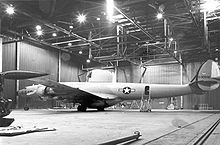
Picture - An EC-121D of the 552nd AEWCW at McClellan AFB.
Initial deployment of EC-121Cs began with the 551st Airborne Early Warning and Control Wing, based at Otis Air Force Base, Massachusetts. Operational on December 21, 1954, the 551st AEWCW subsequently upgraded to EC-121D and later EC-121H Warning Stars. Its Pacific counterpart was the 552nd AEWCW, based at McClellan Air Force Base, California, which became operational on July 1, 1955. After the Cuban Missile Crisis in 1962, the 552nd AEWCW also had administrative control of the 966th AEWCS, based at McCoy Air Force Base, Florida. The 966th had a dual mission: monitoring activity in Cuban airspace and flying Gold Digger missions (continuous tracks of U-2 surveillance missions).
The third Wing to operate EC-121s was the 553rd Reconnaissance Wing, a Vietnam war organization activated in October 1967 and based in Thailand until its inactivation in December 1970 (See BatCat below).
As the USAF prepared to deploy the E-3 Sentry in the later '70s, both the 551st and 552nd AEWCWs phased out EC-121 operations by the end of 1975. All remaining EC-121s were transferred to the Air Force Reserve, which formed the 79th AEWCS at Homestead Air Force Base, Florida in early 1976. The active duty force continued to provide personnel to operate the EC-121s on a 24-hour basis, assigning Detachment 1, 20th Air Defense Squadron to Homestead AFB as associate active duty crews to fly the Reserve-owned airplanes. Besides monitoring Cuban waters, these last Warning Stars also operated from NAS Keflavik, Iceland. Final EC-121 operations ended in September 1978. Detachment 1 was dissolved and 79th AEWCS was re-designated a fighter squadron on 1 October 1978.
In 1967, five EC-121S became operational with the 193rd Tactical Electronic Warfare Squadron of the Pennsylvania Air National Guard, responsible for psyops missions under project Coronet Solo. From July 1970 to January 1971 they rotated on 30-to-90-day temporary duty deployments to Korat RTAFB, Thailand, under the name Commando Buzz.
Vietnam War
EC-121s were used extensively in Southeast Asia between 16 April 1965, and 1 June 1974, particularly in support of Operation Rolling Thunder and Operation Linebacker/Linebacker II to provide radar early warning and limited airborne control of USAF fighter forces engaging MiG interceptors. Flying orbits over the Gulf of Tonkin and later over Laos, they were the forerunners of Airborne Early Warning and Control aircraft.
Big Eye
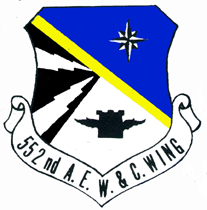
Picture -
At the onset of Rolling Thunder, the North Vietnamese had an advantage in that their radar coverage could detect most US strike aircraft flying at 5000 feet or above virtually anywhere in the country, using a system that was difficult to jam. US forces countered with radar ships ("Crown") in the Gulf of Tonkin and a ground site at Nakhon Phanom RTAFB, Thailand, but both systems were line of sight and had serious gaps in coverage.
To increase coverage the Seventh Air Force (7 AF) requested airborne radar support and the Air Defense Command (redesignated Aerospace Defense Command in 1968) was directed to set up the Big Eye Task Force. Five EC-121Ds and 100 support personnel of the 552nd Airborne Early Warning and Control Wing at McClellan Air Force Base, California, were deployed to Tainan Air Station, Taiwan, with four of the EC-121s sent on to a forward operating location at Tan Son Nhut Air Base, near Saigon, Republic of Vietnam.
The EC-121s were designed for detection of aircraft flying over water, and ground clutter (spurious signal returns off of terrain features such as mountains) caused interference with their radar pictures. Their crews, however, were experienced in tracking Soviet aircraft over Cuba and had developed a technique whereby an EC-121 flying at 50 to 300 feet could bounce a signal from its bottom-mounted APS-95 Search radar off the surface of the water and detect aircraft at medium altitudes out to 150 miles. Operating in pairs, one Big Eye EC-121 flew a 50-mile race track pattern approximately 30 miles offshore (the Alpha orbit), with the orbit's center at 19°25′N 107°25′E / 19.417°N 107.417°E / 19.417; 107.417. The second flew a track at 10,000 feet (the Bravo orbit) farther from the coast, acting as a spare for the Alpha EC-121.
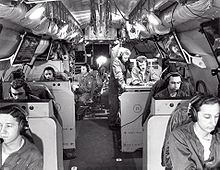
Picture - Radar operators in an USAF EC-121D/H/T.
This provided a practical detection range of 100 miles, just enough to cover the Hanoi urban area and the main MiG base at Phuc Yen. A major disadvantage of this arrangement, however, was that most MiG contacts were beyond the 70-mile range of the Big Eye's APS-45 Height Finder radar, so that they were unable to provide this crucial data to USAF strike forces. Furthermore, technical shortcomings in the EC-121D's systems precluded either controlling a fighter intercept or identifying a specific flight under attack.
The missions from Tan Son Nhut began 21 April 1965, using the call signs Ethan Alpha and Ethan Bravo, which became standard. After refueling at Da Nang Air Base, Ethan Alpha made a wave-top approach to its orbit station, where it remained five hours. Because of the threat of MiG interception, EC-121s were protected by a MiGCAP of F-104 Starfighters, and if for any reason the MiGCAP could not rendezvous, the EC-121s cancelled their mission. Air conditioning systems aboard the EC-121 were virtually useless in this profile and the heat produced by the electronics, combined with the threat of being shot down, made Alpha orbit missions in particular highly stressful. On 10 July 1965, in its first airborne-controlled interception, an EC-121 provided warning to a pair of US F-4C fighters, resulting in the shooting down of two MiG-17s.
The Big Eye Task Force remained at Tan Son Nhut until February 1967, when the threat of Viet Cong ground attacks prompted a move to Thailand.
College Eye
On 1 March 1967, Big Eye was renamed College Eye Task Force and relocated at Ubon RTAFB. Because of the complexity of the aircraft and its systems and the large support group it required, the CETF was not a welcome tenant at the relatively small Thai bases. It moved to Udon RTAFB in July and to its final station at Korat RTAFB on 17 October 1967.
From April 1965 to early 1966 and beginning again in late 1967, the EC-121Ds also controlled a flight of MiGCAP fighters for unarmed support aircraft operating over the Gulf. The EC-121Ds also served as an airborne communications relay center for strike aircraft to transmit mission results and position reports to the control center at Da Nang; directed operations of fighter escorts, MiGCAPs, C-130 flare ships, and A-26 strike aircraft along the North Vietnamese-Laotian border; provided radar and navigational assistance for Combat Search and Rescue missions; and assisted fighters in finding tankers for emergency refueling.
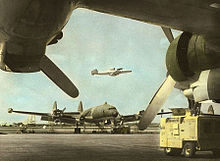
Picture - A "College Eye" EC-121D takes off from Korat RTAFB.
The government of China on 12 May 1966, formally protested an incursion by an F-105 pursuing a North Vietnamese MiG it subsequently shot down 25 miles inside Chinese territory. A US board of inquiry recommended that College Eye also monitor the "no-fly zone" inside the North Vietnamese border with China, provide alerts to US aircraft nearing the buffer zone, and report border crossing violations by US aircraft. This could not be done from the Gulf and a third orbit, called Ethan Charlie, was created in Laos. After tests in June and August, regular missions began 24 August. There were not enough EC-121s or crews to support three orbits twice daily, so the Laotian orbit was only flown every third day, with Ethan Bravo missions cancelled on those days. After 13 October 1966, the Charlie orbit was flown every day and the Bravo orbit suspended altogether. In April 1967, four more EC-121s were deployed, two to Thailand on 29 May, making for a total strength of three College Eyes in Taiwan and six in Thailand.
In April 1967, the Air Force began fitting its entire EC-121 fleet with the QRC-248 IFF transponder interrogator. The QRC-248 had been developed to surveil Soviet-export aircraft flown by the Cuban Air Force. The SRO-2 transponders installed in Soviet export MiGs enabled Cuban ground-controlled interception radars to identify and control their fighters. A test bed EC-121 called Quick Look had flown with College Eye in January 1967 to test the QRC-248 and found that North Vietnamese MiGs used the same transponder. QRC-248 accurately discriminated MiG radar returns from the myriad returns picked up during a mission, and extended the range of low-altitude detection to more than 175 miles, covering virtually all important North Vietnamese target areas.
By 31 May, all College Eyes had been fitted with QRC-248. The mission of the Bravo orbit was changed from that of a backup for the Alpha orbit to being the primary QRC-248 listener. However College Eye was prohibited by the Joint Chiefs of Staff from actively "interrogating" MiG transponders, following a National Security Agency security policy protecting its "intelligence sources" (of which the QRC-248 was one), and thus was restricted to waiting for North Vietnamese GCI to interrogate its planes. QRC-248 began regular use on 21 July 1967, but by then North Vietnam's MiG force, which had suffered serious losses in May, had suspended combat operations.
In the last week of August, however, after a period of intensive training and revision of tactics, the MiGs began to engage US strike forces again, scoring a number of kills. Seventh Air Force finally obtained permission for the Bravo orbit EC-121 to actively interrogate with the QRC-248 on 6 October. By 4 December, its success outweighed any value in flying the Alpha orbit, which was discontinued.
On 1 March 1968, the College Eye call signs were changed to Ethan 01, 02, 03, and 04 in conformity with standard Air Force procedures. Ethan 03 (the Laotian orbit) began "positive control" (airborne direction) of C-130 flare ship flights and A-26 night interdiction missions along the Ho Chi Minh Trail in Laos on April 19, 1968.
The task force was scaled back on 1 July 1968, to four EC-121Ds and the Rivet Top test bed aircraft to allow for the basing of another College Eye detachment at Itazuke AB, Japan. The name of the task force was discontinued on 30 October 1968, when it was redesignated a final time as Detachment 1 (Rotational), 552nd AEWCW. The EC-121 deployments to Southeast Asia were discontinued in June 1970 in the expectation that they would no longer be utilized.
Rivet Top
On 9 August 1967, while the College Eye Task Force was still based at Udon, another prototype EC-121 variation began operations testing new equipment as Detachment 2 of the Tactical Air Warfare Center. Known as Rivet Top, this modified EC-121K (later re-designated EC-121M) carried the QRC-248 newly installed in the College Eye aircraft, but also had electronic interrogators capable of reading two additional Soviet transponders, the SRO-1 and SOD-57. Its electronics were custom-built rather than off-the-shelf. However its most important upgrade was the highly secret "Rivet Gym" installation. This consisted of the addition to the crew of Vietnamese-speaking intelligence specialists who manned four voice communication intercept stations able to monitor all communications between the MiGs and their GCI controllers.
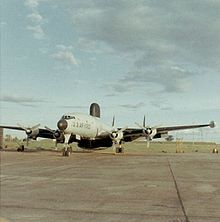
Picture - The EC-121K "Rivet Top" (s/n 57-143184) at Korat, 1967-68.
Despite this advantage, the Rivet Top experienced two problems which reduced its effectiveness. Its listeners did not have radar scopes to correlate intercepted conversations with specific flights of MiGs, and thus could not determine which US aircraft might be under attack. Secondly, like QRC-248, Rivet Gym was a Signal Intelligence ("SIGINT") asset of NSA, and subject to even more stringent rules protecting knowledge of its existence. Even when real-time warnings to US aircraft were finally permitted in mid-1972, fighter crews were not made aware of the source of the warnings and because EC-121 radio communications were so poor, mandating the use of a radio relay aircraft that often failed, they tended to disregard the credibility of the source.
The Rivet Top prototype moved to Korat along with the College Eye Task Force in October 1967. Originally scheduled to return to the United States in February 1968, because of its value it remained at Korat until 1969. Flying daily missions through its testing period, it began flying every-other-day missions over the Gulf of Tonkin after 31 March 1968, when Rolling Thunder operations were sharply scaled back. Rivet Gym installations were back-fitted to all College Eye EC-121s by the end of May 1968.
Operation Kingpin
Two EC-121Ds, newly-modified with the Southeast Asia Operational Requirement 62 (SEAOR-62) electronics suite but not yet operational as EC-121Ts, were ordered to Korat on 29 October 1970. Under the guise of being field tested, they were accompanied by a C-121G carrying 52 crew members, the most experienced technicians of the 552nd AEWCW, and equipment necessary to maintain the new electronics suite. The SEAOR-62 package was supported by a digital data receiver ground terminal and by radio relay equipment transshipped by separate classified airlift. The EC-121Ts arrived in Thailand from McClellan Air Force Base on 12 November.
The purpose of the deployment was to provide an integrated tactical data display with real-time inputs (similar to the Navy Airborne Tactical Data System equipping E-1B Tracer platforms of Task Force 77) in support of Operation Kingpin, a Special Operations mission to rescue prisoners at Son Tay prison. Once at Korat, some equipment was tested for the first time because of emission restrictions in U.S. airspace, and the only available manuals and checklists were notes from early flight tests. Even so, both aircraft were operational by 17 November.
On 20 November 1970, at 22:00 and 22:10, the two Warning Stars, using the call signs Frog 01 and Frog 02 respectively, took off from Korat and took station at the previously established low altitude Alpha orbit over the Gulf of Tonkin, with Frog 02 as a backup standby. The 17-man crews were advised in the air of the nature of the rescue mission and their role to provide MiG warning and to direct Air Force F-4 Phantom CAP intercepts. As Frog 01 began its climb to the higher Bravo orbit, it experienced a ruptured oil line that forced the shutdown of one engine. As planned, Frog 02 became the primary aircraft when Frog 01 made an emergency landing at Danang.
The new equipment failed to function properly aboard Frog 02. The ground receivers at the Kingpin command post in Danang failed to receive data, and the APX-83 IFF processors would not display aboard the aircraft, despite repeated repairs. Their own radar monitors experienced excessive electronic noise, and the jamming of North Vietnamese radars by nearby EKA-3B Skywarriors hindered efforts of the radar technicians to correct the problems. While unable to provide vectoring information to the F-4s escorting the mission, Frog 02 remained on station and relied on its Rivet Top capability to provide supplementary data.
Disco
In October 1971 North Vietnamese MiGs, operating from forward bases opened after the end of Rolling Thunder, began to attempt intercepts of B-52 missions in southern Laos. On 20 November, a MiG-21 actually launched air-to-air missiles at a B-52 which evaded them by dropping flares. As a result, Warning Stars of Det. 1 returned to Korat, Thailand, to provide radar support by flying the Laotian orbit again, using the call sign Disco. Seven EC-121Ts, replacement aircraft for the earlier series, were based in Thailand and contained both QRC-248 and Rivet Top electronic suites.
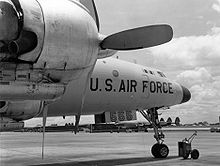
Picture - EC-121D 53-555 at Korat RTAFB in September 1970.
When Operation Linebacker began on 10 May 1972, Disco was one of two principal GCI radars used by U.S. forces, although it continued to be handicapped by poor radio communications. In addition, its slow-turning radar limited its value as a controller of fighters during MiG engagements, while the size of USAF raids during Linebacker nearly saturated its capabilities. However the improvements made in the systems since 1968 enabled the radar operators to distinguish MiG types, and a color code system for them entered the air operations vernacular: "Red Bandits" (Mig-17s); "White Bandits" (MiG-19s); "Blue Bandits" (MiG-21)s, and "Black bandits" (MiGs low on fuel).
On 6 July 1972, as the result of seven F-4 Phantoms shot down in one two-week period, a second Disco track was initiated. Flown near the former Alpha orbit over the Gulf of Tonkin, its purpose was to gain better low-altitude coverage in the Hanoi area. At the end of the month Disco was also integrated into the "Teaball" control center, a highly classified system established to collate all signal intelligence on North Vietnamese air activity gathered by all intelligence sources, including non-military. Disco was used as a conduit through which warnings and control vectors were given, but the delay in Teaball acquiring and relaying the information through Disco (which often had to use an unreliable radio relay KC-135A Combat Lightning aircraft operating under the call sign Luzon) cancelled out its value for use in "real time", and the fact that its existence was kept from US air crews damaged its credibility.
On 15 August 1973, Disco EC-121s flew their final combat mission, and on 1 June 1974, Detachment 1 was permanently withdrawn from Southeast Asia. Between 1965 and 1973 the EC-121s flew 13,921 combat missions; more than 98,000 accident-free flying hours; assisted in the shoot-down of 25 MiGs; and supported the rescue of 80 downed flyers. No Big Eye, College Eye, or Disco aircraft were lost.
Batcat
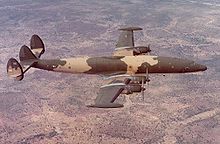
Picture - EC-121R Batcat
During the Vietnam War some 30 EC-121s were modified from U.S. Navy WV-2 and WV-3 early warning Constellations for use with ground sensors to detect enemy troop movements along the Ho Chi Minh Trail, and 25 were deployed to Southeast Asia, at Korat Royal Thai Air Force Base, as a part of Operation Igloo White. The resulting EC-121R configuration was nicknamed the Batcat. Two Batcats were lost during the war, with the loss of 22 crewmen, one in a takeoff accident during a thunderstorm on 25 April 1969, the other on 6 September 1969, in a landing accident. Four Thai civilians on the ground were also killed in the second crash.
Batcat EC-121s were camouflaged in the standard three-color Southeast Asia scheme while the College Eye/Disco early warning aircraft were not. BatCat missions were 18 hours in length, with eight hours on station at one of 11 color-coded orbits used during their five year history, three of which were over South Vietnam, six over Laos, one over Cambodia, and one over the Gulf of Tonkin.
EC-121Rs were operated by the 553rd and 554th Reconnaissance Squadrons of the 553rd Reconnaissance Wing, between 19 October 1967, and 15 December 1970, with approximately 20 Batcats on hand at any one time. The Wing was inactivated 15 December 1970, and the 554th RS relocated to Nakhon Phanom RTAFB to fly QU-22 sensor monitors nicknamed "Baby Bats". Initially with 11 aircraft, the 553rd RS continued operations for another year, gradually returning planes and crews to the United States. The final Batcat mission was flown 5 December 1971. The last remaining administrative and support personnel returned to Otis Air Force Base, Massachusetts, in January 1972.
Variants
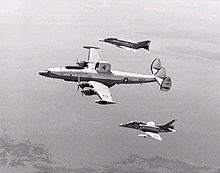
Picture - VAQ-33 NC-121K in 1973, flanked by an F-4B Phantom II and an EA-4F Skyhawk.
U.S. Navy variants
WV-1
Two prototypes, L-749A Constellation, designated PO-1W before 1952
EC-121K (WV-2)
Main USN variant, designated PO-2W before 1952. 244 ordered, 142 produced (the rest went to the USAF).
JC-121K
one modified EC-121K used as a U.S. Army avionics testbed
NC-121K
unknown number modified as special mission aircraft
YEC-121K
one modified avionics testbed
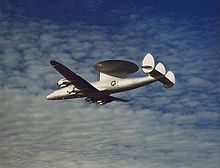
Picture - The WV-2E experimental aircraft with a rotodome.
EC-121L (WV-2E)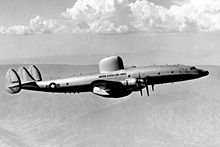
Picture - The first USAF RC-121C, 1955.
RC-121C
10 produced, initial USAF variant
JC-121C
two converted from C-121C and one TC-121C as avionics testbeds
TC-121C
9 RC-121C modified before 1962 as crew trainers
EC-121D
73 produced 1953-55 as main USAF variant and one converted from C-121C, originally designated RC-121D
EC-121D Quick Look
one testbed for QRC-248 IFF transponder interrogator
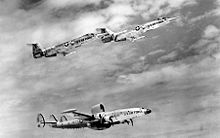
Picture - The USAF RC-121D 53-0128 with two F-104 Starfighters.
EC-121H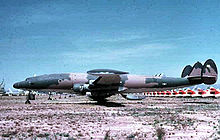
Picture - A former EC-121R Batcat at AMARC, Davis-Monthan AFB, Arizona.
30 EC-121K / EC-121P transferred to USAF in 1966-67 and converted to Batcat sensor signal processorOperators
United States
United States Air Force
551st AEWCW - Otis AFB, Massachusetts
960th AEWCS
961st AEWCS
962d AEWCS
552d AEWCW - McClellan AFB, California
963d AEWCS
964th AEWCS
965th AEWCS
553d RW - Korat RTAFB, Thailand
553d RS
554th RS
966th AEWCS - McCoy AFB, Florida
Det. 1, 20th ADS - Homestead AFB, Florida
79th AEWCS (AFRES) - Homestead AFB, Florida
193d TEWS (ANG) - Olmsted Air Force Base, Pennsylvania
United States Navy
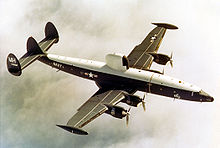
Picture - WC-121N of VW-4 Hurricane Hunters in 1967
AEW Wing Atlantic - NAS Patuxent River, Maryland
VXN-8 - NAS Patuxent River, Maryland
VW-2 (BarLant) -NAS Patuxent River, Maryland
VW-4 ("Hurricane Hunters") - NAS Jacksonville, Florida
VW-11 (BarLant) - NAS Argentia, Newfoundland / NAS Patuxent River, Maryland
VW-13 (BarLant) - NAS Patuxent River, Maryland / NS Argentia, Newfoundland
VW-15 (BarLant) - NAS Argentia, Newfoundland / NAS Patuxent River, Maryland
Naval CIC Officers School, later Training Squadron Eighty-Six (VT-86) - NAS Glynco, Georgia
AEW Wing Pacific - NAS Barbers Point, Hawaii
VW-1 ("Typhoon Trackers") - NAS Agana, Guam
VW-3 ("Typhoon Chasers") - NAS Agana, Guam
VW-12 (BarPac) - NAS Barbers Point, Hawaii
VW-14 (BarPac) - NAS Barbers Point, Hawaii
VW-16 (BarPac) - NAS Barbers Point, Hawaii
AewBarsRon 2 (Service/Support) - NAS Barbers Point, Hawaii
MatRon 1 (Support) - NAS Barbers Point, Hawaii
AewBarRonPac (amalgamation of VW-12, VW-14, and AEWBarRon 2) - NAS Barbers Point, Hawaii
VQ-1 - NAF Atsugi, Japan
VQ-2 - NS Rota, Spain
VAQ-33 - NAS Norfolk, Virginia / NAS Key West, Florida
VXE-6 - NAS Quonset Point, Rhode Island
Operational losses
A total of 20 Navy EC-121s were destroyed in accidents, with 113 aircrew deaths:
15 WV-2/EC-121K
3 WV-2Q/EC-121M
2 WV-3/WC-121N
Another EC-121M was destroyed in combat. In 1969 North Korean fighters shot down an EC-121 off the country's east coast, killing all of the crew of 31 on board.
The USAF had a total of 11 Warning Stars destroyed in accidents, killing 72 aircrew:
2 RC-121C/TC-121C
2 RC-121D
3 EC-121H
3 EC-121R
1 EC-121T
3 EC-121Hs from the 551st AEWCW were lost on July 11, 1965; November 11, 1966; and April 25, 1967, resulting in 50 deaths, including the wing commander of the 551st AEWCW, Col. James P. Lyle. The two Batcat EC-121R crashes resulted in 22 killed.
Survivors
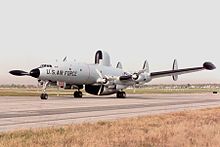
Picture - College Eye EC-121D (AF Ser. No. 53-0555) at the National Museum of the United States Air Force
EC-121T, AF Serial No. 52-3417 (N4257L) is located at University of Montana at its University of Montana-Helena College of Technology facility in Helena, Montana. The aircraft is the oldest surviving EC-121, and was delivered to the USAF as a RC-121D in September 1954, and upgraded to an EC-121T in 1970. It served with the Air Force Reserve at Homestead Air Force Base before being retired to Davis-Monthan Air Force Base in March 1976. In the early 1980s, the university purchased the aircraft from the Air Force for $10,000 and it was ferried to the university in July 1981. In spring 2009, it was declared surplus by the university and offered to any museum interested in preserving it.
EC-121T, AF Serial No. 52-3418 (N4257U), c/n 4336, final registration N4257U is on display at the Combat Air Museum in Topeka, Kansas. The aircraft was delivered to USAF in October 1954 as an RC-121D and redesignated an EC-121D in 1962. It was converted to an EC-121T, but the upper radome has been removed.
EC-121T, AF Serial No. 52-3425, is on display at the Peterson Air and Space Museum at Peterson AFB in Colorado Springs, Colorado. Previously assigned to the 966th AEWCS at McCoy AFB, Florida and then the 79th AEWCS at Homestead AFB, Florida, it was the last operational EC-121 and was deployed by the 79th AEWCS to NAS Keflavik, Iceland. It was delivered to Peterson AFB in October 1978.
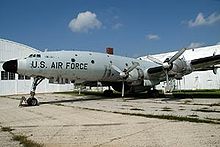
Picture - N4257U (AF Ser No. 52-3418) on display at the Combat Air Museum in Topeka, KS.
EC-121T, AF Serial No. 53-0548, is on display at the Yanks Air Museum in Chino, California.
EC-121K, AF Serial Number 53-0552 (Navy BuNo 141309), is on display at the Aerospace Museum of California at the former McClellan AFB, California. This aircraft has seen both USAF and USN service.
EC-121T, AF Serial No. 53-0554, is on display at the Pima Air & Space Museum, adjacent to Davis-Monthan AFB in Tucson, Arizona.
EC-121D, AF Serial No. 53-0555 is on display at the National Museum of the United States Air Force at Wright-Patterson Air Force Base near Dayton, Ohio. The College Eye EC-121D is fully restored and on display indoors. This aircraft was nicknamed "Triple Nickel" because of its serial number (53-555). On October 24, 1967, while operating over the Gulf of Tonkin, it guided a U.S. fighter by radar into position to destroy an enemy fighter aircraft, a MiG-21. This was the first time a weapons controller aboard an airborne radar aircraft had ever directed a successful attack on an enemy plane. "Triple Nickel" was retired to the USAF Museum in 1971.
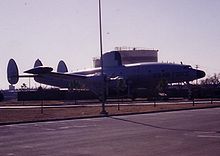
Picture - EC-121 on display at Tinker AFB
EC-121, Navy BuNo 137890, is on display at Tinker Air Force Base, in Oklahoma City, Oklahoma. The aircraft is on static display outside 552d Air Control Wing Headquarters, the home of E-3B/C AWACS operations for the USAF.
EC-121K, Navy BuNo 141297, is on display at the Museum of Aviation at Robins Air Force Base, Georgia. It was flown to the museum in 1987 for display.
EC-121D, Navy BuNo 141311, is on display at the Chanute Aerospace Museum at the former Chanute AFB in Rantoul, Illinois.
EC-121, Navy BuNo 143221, is on display at the National Museum of Naval Aviation at Naval Air Station Pensacola in Pensacola, Florida. The aircraft was acquired in flyable condition in 1973 from Training Squadron 86 (VT-86) at NAS Glynco, Georgia. It is on display at the Sherman Field flight line annex of the museum.
EC-121T (N6937C) is on display at the Airline History Museum in Kansas City, Missouri.
Specifications (WV-2/EC-121D)
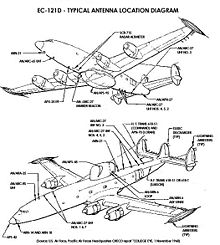
Picture - EC-121D antenna location diagram.
Data from
General characteristics
Crew: typically 6 flight crew, 11-25 radar crew
Length: 116 ft 2 in (35.40 m)
Wingspan: 126 ft 2 in (38.45 m)
Height: 24 ft 9 in (7.54 m)
Wing area: 1,650 ft² (153.27 m²)
Empty weight: 69,210 lb (31,387 kg)
Max takeoff weight: 143,000 lb (65,000 kg)
Powerplant: 4x— Wright R-3350-34 Turbo Compound 18-cylinder supercharged radial engines, 3,400 hp (2,536 kW) each
Performance
Maximum speed: 299 mph (260 kt, 481 km/h)
Cruise speed: 255 mph (222 kt, 410 km/h)
Range: 4,250 mi (3,700 nm, 6,843 km)
Service ceiling: 25,000 ft (7,620 m)
Rate of climb: 960 ft/min (4.87 m/s)
Related development
Lockheed Constellation
L-1649A Starliner
Comparable aircraft
E-3 Sentry
Tupolev Tu-126
Bibliography
Extract of USAF College Eye Report
Gargus, John. The Son Tay Raid: American POWs in Vietnam Were Not Forgotten. College Station, TX: Texas A&M Press, 2007. ISBN 1-58544-622-X.
Michel, Marshall L. Clashes: Air Combat Over North Vietnam 1965-1972. Annapolis, MD: Naval Institute Press, 1997. ISBN 1-55750-585-3.
Lockheed EC-121 Warning Star Pictures and Lockheed EC-121 Warning Star for Sale.
Living Warbirds: The best warbirds DVD series.
Source: WikiPedia